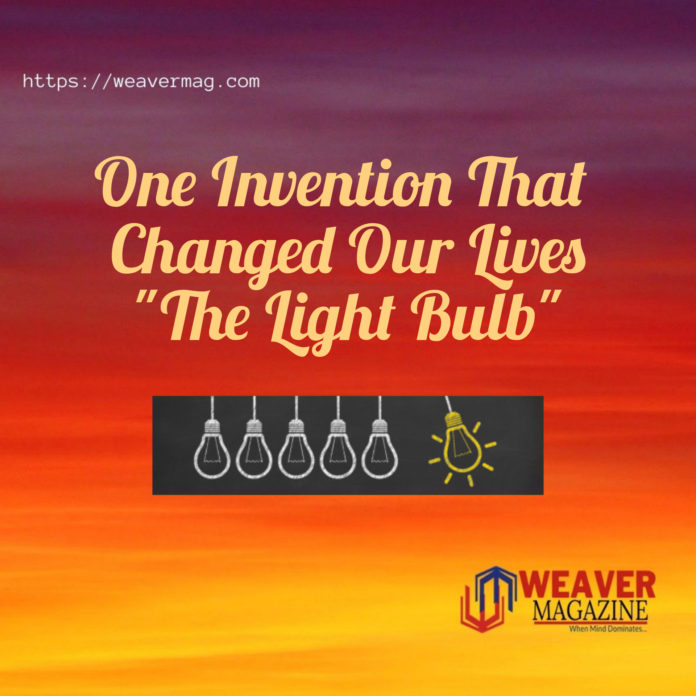ONE OF THE GREATEST
INVENTION: THE LIGHT BULB
“I didn’t fail 1000 times. The light bulb was an invention with 1000 steps”
-Thomas Alva Edison
Like all other great inventions, the light bulb can’t be credited to one inventor. Some historians claim there have been over 20 inventors of incandescent lamps before Edison’s
version. However, Edison is usually credited with the invention because his version was ready to outstrip the earlier versions. This was made possible just because of a combination of three factors: an efficient incandescent material, a far better vacuum than others were able to achieve, and a high resistance that made the distribution of power from a centralized source economically viable.
This one invention proved out to be an evolution in the history of mankind.
A BRIEF HISTORY OF THE LIGHT BULB:
Before Edison, the British Chemist Warren de La Rue had solved the scientific challenges nearly 40 years earlier by using thin – and thus high-resistance – filaments to achieve the brightness, and delayed burnout by making them from high-melting-point metal sealed at the time of a vacuum. But unfortunately, these early bulbs had extremely short lifespans, were too expensive to produce, or used too much energy.
In 1878, another British chemist, Joseph Swan, publicly demonstrated the first light supported commercially-viable carbon, but his use of relatively thick filaments still led to
rapid burnouts resulting in utter failure.
THOMAS EDISON AND THE “FIRST LIGHT BULB”:
In 1878 after Swan, Edison began serious research into developing a practical incandescent lamp and on October 14, 1878, Edison filed his first patent for “Improvement In Electric Lights.”
Simultaneously, he continued to test several types of material for metal filaments to enhance upon his original design and by Nov 4, 1879, he filed another U.S. patent for an electric lamp which uses “a carbon filament or strip coiled and connected … to platina contact wires.”
By October 1879, Edison’s team had produced a light bulb with a carbonized filament of uncoated cotton thread that would last for 14.5 hours. Meanwhile, they continued to experiment with the filament until settling on one made from bamboo that gave Edison’s lamps a lifetime of up to 1,200 hours which was too improbable for belief.
This discovery marked the beginning of commercially manufactured light bulbs and in 1880, Thomas Edison’s company, Edison Electric Light Company began all over the world.
THE FUTURE IS HERE: LEDs
One of the fastest developing lighting technologies used by most of us today is the light-emitting diode (or LED).
These are a type of solid-state lighting that uses a semiconductor to convert electricity into light and are often small in area and emit light in a specific direction, reducing the need for reflectors, diffusers, etc. that can trap light.
SOME OTHER NOTABLE DATES IN ITS HISTORY:
We know that it was a series of small improvements on the ideas of previous inventors that have led to the light bulbs we use in our homes today.
- 1906 – The General Electric Company became the first to patent a method of making tungsten filament.
- 1910 – William David Coolidge improved the process of manufacturing for making the longest-lasting tungsten filaments.
- The 1920s: The first frosted lightbulb was produced with adjustable power beam bulbs for car headlamps, and neon lighting, etc.
- The 1930s: This period saw the invention of a little one- time flashbulbs for photography, and the fluorescent tanning lamps.
- The 1940s: The first ‘soft light’ incandescent bulbs were introduced.
- The 1950s: Quartz glass and halogen light bulbs were produced.
- The 1980s: New low wattage metal halides were created.
- The 1990s: Long-life bulbs and Compact Fluorescent bulbs made their debut.
HOW IT CHANGED THE WORLD?
There had been only light before the lightbulb. People all over the world were using candles and gas lamps to light their homes, and street lamps popped up towards the end of the 17th century. But with the invention of the light bulb, the limitations of the old lighting methods were eradicated. In the years since the light bulb was invented, there have been more technological advancements seen than in any other historical period.
People could now carry on with their daily lives in the evening. Production of goods increased rapidly because factory and mill employees could work through the night. The population of the towns surrounding the factories and mills grew as people moved to find work or to find cities and towns in which they could open their businesses.
This one invention revolutionized the way to view work and paved the way for a century of very fast progression.
“Necessity is the mother of all invention”
-Albert Einstein











